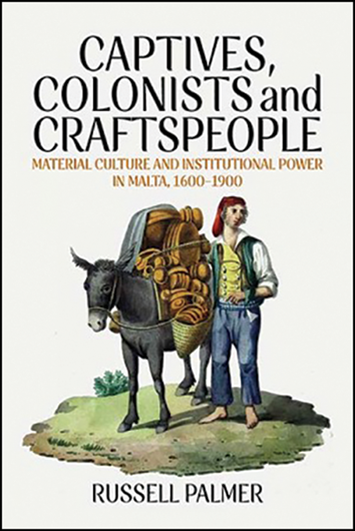
Malta was known as the last bastion of the Catholic faith against the Ottoman Empire in the east as Protestantism rose in the west; home of the Knights Hospitaller (equal part crusader and corsair), Roman Inquisitors, Indigenous Maltese, galley slaves and prisoners. An archipelago governed under the divided rule of the Order of the Knights of St John, the Church and the Roman Inquisition throughout much of the modern period (1530–1798). Under British rule, from 1814, the islands became a waystation for a variety of colonial agents and eventually served as an important port of call along the trade route through the Suez Canal in the late nineteenth century. While regularly the subject of study during Antiquity—owing to colonisation by Prehistoric, Greek, Phoenician, Punic and Roman invaders—the Central Mediterranean is often overshadowed in research terms by trans-Atlantic studies due to the shift in economic activity with the Western ‘discovery’ of the ‘New’ World.
In Captives, colonists and craftspeople: material culture and institutional power in Malta, 1600–1900, Russell Palmer builds on the sparse literature about the archaeology of the modern period in Malta and develops a comprehensive foundation for an historical archaeology of the archipelago. This broad undertaking is presented in six thematic chapters that cross-cut the diverse populations of the islands throughout the early and late modern period. Palmer draws upon a variety of sources including archival documents, blueprints and innovative approaches to material culture analysis of previously excavated archaeological deposits and prisoner graffiti. The results provide a history not of dominator and oppressed nor of colonised and coloniser but one in which multiple agents are caught within institutional structures of power outside of themselves, no matter their positioning. Palmer introduces us to each of the demographics listed above in Chapter 1 ‘Institutional agents’.
In Chapter 2, the author critically engages with ‘Institutional spaces’ through an application of space syntax analysis on each of the sites discussed in this publication. These include penal architectures from religious confinement in the Roman Inquisitors’ prisons to sites of civilian and military confinement. Palmer also analyses military environments, specifically an army officers’ mess hall and a galley ship. The latter “is the only nonterrestrial environment examined and, given the restrictions of space, discussion focuses on the unique human make-up of the environment” (p.15). The analysis of the galley and the life of the galley slave throughout the work is one of the most interesting threads that Palmer weaves through the book.
Chapters 3 and 4 move away from people and places toward an examination of ‘Productive labour’ and ‘Foodways’, respectively. Discussed together here, each chapter offers a thorough analysis of the lives of people from galley slaves to British officers. Although more in-depth material culture analysis is provided later in the book, in the discussion of labour and local craft production, Palmer provides the reader with a detailed description of the local pottery production techniques from this period which will be, for many archaeologists, worth its weight in salt or in this case ‘sea-sand temper’. In Chapter 4, drawing heavily upon historic documents and archaeological evidence, foodways are examined—beginning with the soups, breads and pasta that made up the majority of Indigenous Maltese meals. This is followed with a detailed discussion of the foodways of the other demographics of the study including prisoners, galley slaves, as well as the British officers’ and galley captains’ tables.
Although archaeological and material culture analysis is presented throughout the book, Chapter 5, ‘Material routines’, provides the bulk of the analysis through an examination of everyday practices. Palmer begins with a discussion of the captives of the Inquisition coping with their confinement by etching graffiti into the walls of their prison; there is a detailed thematic discussion of graffiti typology from a sundial high on the wall of the prison courtyard, to intricate rosettes, to a series of nautical graffiti (notable in various contexts throughout the Maltese islands). He observes that “for captive galley rowers-cum-prisoners, ships represented both their future prisons and their only way to freedom … necessitating complicated relationships with their representations” (p.185). Although some interpretation of the potential meaning of the various graffiti types is offered, it is the incorporation of the graffiti into an architectural framework that delivers a compelling discussion of prisoner mobility and potential surveillance at these sites. The following chapter discusses materials of distraction, in the form of tobacco pipes and game pieces recovered from the Dockyard Creek, which likely originated from the galleys docked there and the enslaved individuals confined to them. The chapter concludes with a study of compliance as evidenced in the material remains from the officers’ mess hall, which previously served as the Inquisitors’ palace. Chapter 6 contextualises modern Malta in an increasingly globalising world as evidenced by historical documents and material culture. The book concludes with a summary of the major issues and themes discussed throughout.
Heeding Charles Orser's warning that “historical archaeologists who continue to ignore the Mediterranean will never truly understand the motivations and designs of oceangoing Europeans” (Orser Jr. Reference Orser1996: 195), Palmer presents an anaylsis of material culture and institutional power, including diverse demographics and across the Maltese islands. Maps (pp. 3–5), black-and-white photographs and illustrations throughout provide the necessary textural elements. Importantly, Palmer offers a much-needed treatment of confinement and enslavement, terrestrial and otherwise, in the Central Mediterranean. He does so in a way that acknowledges the agency, if limited, of the captive, rather than depicting them as caricatures of domination and resistance. Captives, colonists and craftspeople provides an excellent analysis and unique case study of historical archaeology on the Maltese islands and, although at times the historical statistical information can be difficult to parse, the text will engage both the professional and amateur archaeologist alike.


